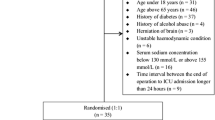Abstract
Background
Daily weight (DW) and examination of fluid balances (FB) are commonly used in assessments of extracellular fluid (ECF) and circulating blood volume (BV). We hypothesized that a calculated total body exchangeable solute, the main determinant of the ECF, would have high agreement and correlation with actual BV.
Methods
The University of Washington IRB approved the study. We included a sample of consecutive adult patients in whom a BV was measured, while in the neuroscience intensive care units of a large academic medical center. BV was measured as part of routine care using iodinated 131I albumin injection and the BVA-100 (Daxor Corp, New York, NY, USA). Total body exchangeable solute was estimated at the time of BV measurement by multiplying the calculated total body water by the sum of the sodium plus potassium and chloride measured in plasma. The correlation between the change in DW, FB (adjusted for insensible fluid loss), exchangeable solute, and BV was performed using linear regression with adjustment for number of days between admit and BV measurement, and capillary leak. Errors were computed using robust variance estimation.
Results
55 patients had BV tests available, and 43 of them had subarachnoid hemorrhage. Total body exchangeable solute strongly correlated with BV (r = 0.75, 95 % CI 0.63–0.84, p < 0.01 for Na+/K+, and r = 0.71, 95 % CI 0.58–0.81, p < 0.01 for Cl−). DW (r = 0.21) and FB (r = 0.11) were not correlated with BV.
Conclusions
Total body exchangeable solute appears to be a valid and reliable measure of BV and can be calculated using information readily available at the bedside. The value of having this information automatically calculated and available at the bedside should be explored.


Similar content being viewed by others

References
McGee S, Abernethy WB 3rd, Simel DL. The rational clinical examination. Is this patient hypovolemic? JAMA. 1999;281:1022–9.
Chung HM, Kluge R, Schrier RW, Anderson RJ. Clinical assessment of extracellular fluid volume in hyponatremia. Am J Med. 1987;83:905–8.
Stéphan F, Flahault A, Dieudonné N, Hollande J, Paillard F, Bonnet F. Clinical evaluation of circulating blood volume in critically ill patients—contribution of a clinical scoring system. Br J Anaesth. 2001;86:754–62.
Rothe CF, Murray RH, Bennett TD. Actively circulating blood volume in endotoxin shock measured by indicator dilution. Am J Physiol. 1979;236:H291–300.
Stéphan F, Novara A, Tournier B, et al. Determination of total effective vascular compliance in patients with sepsis syndrome. Am J Respir Crit Care Med. 1998;157:50–6.
Bogaard HJ, de Vries JP, de Vries PM. Assessment of refill and hypovolaemia by continuous surveillance of blood volume and extracellular fluid volume. Nephrol Dial Transplant. 1994;9:1283–7.
http://www.daxor.com/howitworks.asp. Accessed 1 Apr 2013.
Watson PE, Watson ID, Batt RD. Total body water volumes for adult males and females estimated from simple anthropometric measurements. Am J Clin Nutr. 1980;33:27–39.
Spital A, Sterns RD. The paradox of sodium’s volume of distribution. Why an extracellular solute appears to distribute overtotal body water. Arch Intern Med. 1989;149:1255–7.
Carlotti AP, Bohn D, Rutka JT, et al. A method to estimate urinary electrolyte excretion in patients at risk for developing cerebral salt wasting. J Neurosurg. 2001;95:420–4.
Cox P. Insensible water loss and its assessment in adult patients: a review. Acta Anaesthesiol Scand. 1987;31:771–6.
http://www.daxor.com/sitingreq.pdf. Accessed 22 Aug 2013.
Bland JM, Altman DG. Statistical methods for assessing agreement between two methods of clinical measurement. Lancet. 1986;327:307–10.
http://www.crash.lshtm.ac.uk/Risk%20calculator. Accessed 22 Aug 2013.
Perren A, Markmann M, Merlani G, Marone C, Merlani P. Fluid balance in critically ill patients. Should we really rely on it? Minerva Anestesiol. 2011;77:802–11.
Schneider AG, Baldwin I, Freitag E, Glassford N, Bellomo R. Estimation of fluid status changes in critically ill patients: fluid balance chart or electronic bed weight? J Crit Care. 2012;27:745.e7–12.
Eastwood GM. Evaluating the reliability of recorded fluid balance to approximate body weight change in patients undergoing cardiac surgery. Heart Lung. 2006;35:27–33.
Geers AB, Koomans HA, Boer P, Dorhout Mees EJ. Plasma and blood volumes in patients with the nephrotic syndrome. Nephron. 1984;38:170–3.
Lucas CE, Ledgerwood AM, Rachwal WJ, Grabow D, Saxe JM. Colloid oncotic pressure and body water dynamics in septic and injured patients. J Trauma. 1991;31:927–31.
Sánchez M, Jiménez-Lendínez M, Cidoncha M, et al. Comparison of fluid compartments and fluid responsiveness in septic and non-septic patients. Anaesth Intensive Care. 2011;39:1022–9.
Marik PE, Baram M, Vahid B. Does central venous pressure predict fluid responsiveness? A systematic review of the literature and the tale of seven mares. Chest. 2008;134:172–8.
Alrawi SJ, Miranda LS, Cunningham JN Jr, Acinapura AJ, Raju R. Correlation of blood volume values and pulmonary artery catheter measurements. Saudi Med J. 2002;23:1367–72.
Yamauchi H, Biuk-Aghai EN, Yu M, et al. Circulating blood volume measurements correlate poorly with pulmonary artery catheter measurements. Hawaii Med J. 2008;67:8–11.
Moran S, Yu M, Pei K, Takanishi D. The relationship between IVC collapsibility ratio and measured whole blood volume in surgical critical care patients. Crit Care Med. 2009;37:A86.
Financial Support
None.
Author information
Authors and Affiliations
Corresponding author
Electronic supplementary material
Below is the link to the electronic supplementary material.
Rights and permissions
About this article
Cite this article
Joffe, A.M., Healey, L., Khandelwal, N. et al. Validity of Exchangeable Solute Balance as a Measure of Blood Volume in Neurologically Injured Adults. Neurocrit Care 21, 102–107 (2014). https://doi.org/10.1007/s12028-013-9915-1
Published:
Issue Date:
DOI: https://doi.org/10.1007/s12028-013-9915-1



